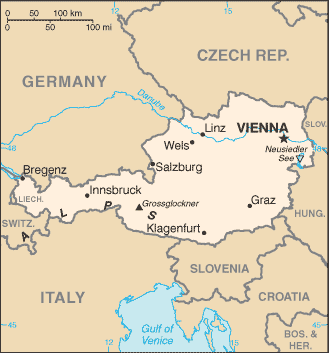Map:

Overview:
Once the center of power for the large Austro-Hungarian Empire, Austria was reduced to a small republic after its defeat in World War I. Following annexation by Nazi Germany in 1938 and subsequent occupation by the victorious Allies in 1945, Austria's status remained unclear for a decade. A State Treaty signed in 1955 ended the occupation, recognized Austria's independence, and forbade unification with Germany. A constitutional law that same year declared the country's "perpetual neutrality" as a condition for Soviet military withdrawal. Following the Soviet Union's collapse in 1991 and Austria's entry into the European Union in 1995, some Austrians have called into question this neutrality. A prosperous, democratic country, Austria entered the Economic and Monetary Union in 1999.
The People:
Population:
8,184,691 (July 2005 est.)
Age structure:
0-14 years: 15.6% (male 656,058/female 624,574)
15-64 years: 67.8% (male 2,790,673/female 2,756,612)
65 years and over: 16.6% (male 543,626/female 813,148) (2005 est.)
Religions:
Roman Catholic 73.6%, Protestant 4.7%, Muslim 4.2%, other 3.5%, unspecified 2%, none 12% (2001 census)
Government Type:
federal republic
Leader(s) to pray for:
chief of state: President Heinz FISCHER (since 8 July 2004)
head of government: Chancellor Wolfgang SCHUESSEL (OeVP)(since 4 February 2000); Vice Chancellor Hubert GORBACH (since 21 October 2003)
Source: The World Factbook
View All Countries